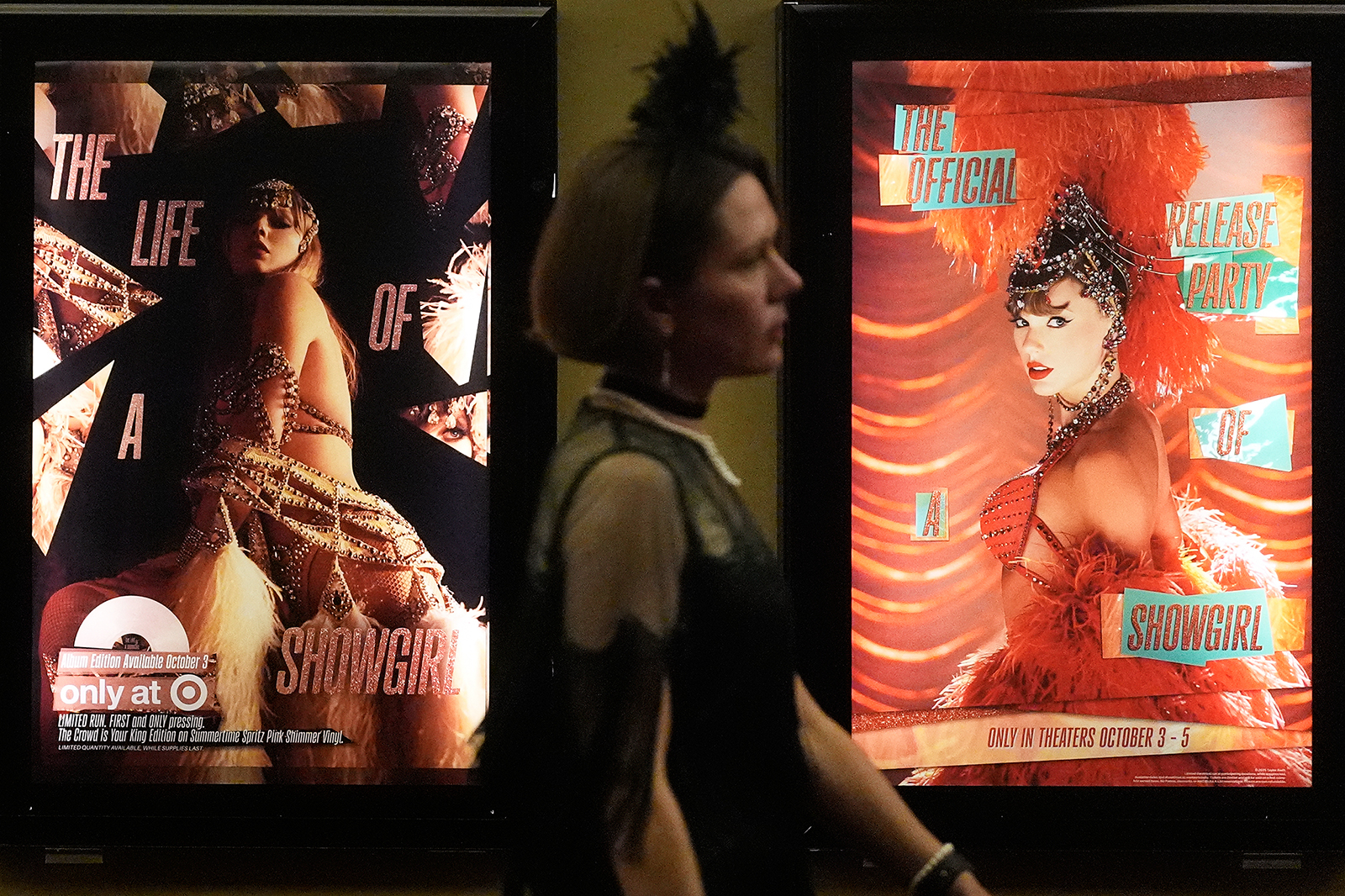
(RNS) — Every morning on the way to school, Susannah Coe, a 12-year-old living in Connecticut, picks the day’s soundtrack in her family’s car. It’s always the same voice coming through the speakers: Taylor Swift’s. Whether it’s a heartbreak ballad, a glittering pop anthem or a country tale of small-town love, the singer’s music has become the rhythm of Susannah’s family drives, a ritual.
But in the two weeks leading up to Oct. 3 — the release of Swift’s album “The Life of a Showgirl” — Susannah didn’t have to decide what to play. Following a fan-made campaign spread across Instagram, YouTube and other social media, she joined “Swifties” around the world in a kind of pop-music Advent calendar: listening to one of the artist’s 11 previous albums each day, in order. Online, fans of all ages traded their favorite songs, memories and photos, counting down to what they called “the next era” of Swift’s work.
It’s just one example of how the pop industry, of which Swift is a leading figure, reproduces logics that draw on the structure of religious rituals, creating community and a sense of belonging. For some die-hard fans, idols occupy a large part of their identity, time and social life. Their near-religious devotion shows how fandom now fills spaces where traditional faith has lived.
In Brazil, 26-year-old Naira Lise Santos de Aquino helps run one of the largest Swift fan pages in Portuguese: Update Swift Brasil, with nearly 400,000 followers across platforms. What began as a teenage hobby has turned into a volunteer network of fans who coordinate campaigns, post translations and share the latest Swift news. Similar pages exist in dozens of other countries and languages organized organically by fans who rarely meet in person but share a common interest.
For Aquino, it’s “a way of being part of something meaningful,” she told RNS. Even now, as an adult balancing her job with managing the fan community and everyday life, she said it’s deeply rewarding to connect people in different places.

Taylor Swift performs during “The Eras Tour” on May 5, 2023, at Nissan Stadium in Nashville, Tenn. (AP Photo/George Walker IV)
The idea of creating an Advent-style countdown campaign first came from Aquino’s team of volunteers last year, around the release of another Swift album, “The Tortured Poets Department,” and was improved for the latest album to engage more fans. For “The Life of a Showgirl,” they also created virtual rooms to host listening parties. Dozens of fans joined daily in a kind of shared liturgy, listening to Swift’s entire discography together, Aquino said.
Other fan pages built out similar ideas, designing post templates and calendars so fans could easily listen to the album at the same time and share their favorite songs on social media, raising expectations for the big release day.
In recent years, Swift’s ever-growing group of devoted fans has been well-served with what some might call “canonical” moments in Swift’s life and career. They gathered for the record-breaking “Eras Tour”; followed her highly publicized relationship with NFL star Travis Kelce; and watched her hard-fought effort to reclaim ownership of her masters.
Meanwhile, new albums have arrived almost every year — in addition to re-releases of her older records — each with marketing campaigns filled with Easter eggs, or hidden clues hinting at upcoming release dates or song titles. Her followers decode the messages disguised in numerology and symbols, participating in rituals that bind them together across borders.
Although pop-star fan clubs have long been common, Aquino said that in Swift’s case, a mix of timing — she became an international icon as social media was exploding — and deliberate marketing strategies was key to making Swifties so devoted. Swift was an early pioneer in intentionally building communities, Aquino said, and that approach inspires fans to do the same.

Taylor Swift performs during the Rock and Roll Hall of Fame induction ceremony, Oct. 30, 2021, in Cleveland. (AP Photo/David Richard)
Beyond that, Aquino said she believes the world Swift creates in her lyrics also strengthens their sense of belonging — a feeling of being part of a magical, enduring community. She points to the 2010 song “Long Live,” where Swift sings: “Long live the walls we crashed through / How the kingdom lights shined just for me and you / I was screaming, ‘Long live all the magic we made’ (…) / One day we will be remembered,” which especially reflects that fan-idol connection that allows listeners to share in Swift’s accomplishments.
“The Life of a Showgirl,” according to Billboard, set single-week records for the most album copies sold. All 12 tracks at some point placed in the top 12 of the Billboard Hot 100, led by the first single, “The Fate of Ophelia.” The album continues to dominate charts.
The commercial success, however, didn’t come without controversy. A New York Times story described the album’s “emotional texture [as] curiously flat and joyless,” while other critics dismissed parts of it as “cringe” or “tone-deaf.” Even fans flooded social media with criticism and disappointment, with some saying they found some lyrics to be racist or regressive, notably “trad-wife coded.” Still, none of that stopped Swifties from clearing store shelves and packing movie theaters for the accompanying concert film.
“For some outside observers, it might seem strange that a critical flop could be such a popular success,” said Kathryn Lofton, a religious studies professor at Yale University in New Haven, Connecticut, who has written about celebrity devotion. “They don’t realize how much goes into anticipating a Taylor Swift album. It doesn’t matter what the album is — it’s the practice of being together and witnessing her power that her fans so enjoy, and then carrying that feeling into the community.”
While comparisons between celebrity and religious devotion are common, religion scholars tend to be more cautious about drawing direct parallels. Still, Lofton said a celebrity can be understood as a kind of divine figure because the ability to attract constant attention is like a superhuman power, one that most people never experience.
“The celebrity is someone who might be a musician or an actor, but something about who they are makes them of interest to even those who haven’t seen their films or listened to their music,” she said. “They become newsworthy in part because they have consented to circulate at a higher rate.”
While magazines emphasize that celebrities are “just like us,” the key difference is that the public cares about their ordinary actions. There’s a dual dynamic at work — one part projection, in which fans romanticize a celebrity’s distant, glamorous life, and one part identification, in which they find something in common.
Lofton said Swift has the kind of capacity to craft “dreaming fantasies of forest romances” while simultaneously living a highly visible, financially powerful international career. “One of the reasons Taylor Swift has been such a successful, world-historic celebrity is because she is very consensual and constructive in her circulation,” Lofton added. “She is invested in conducting the attention paid to her to a profitable effect.”
And in a world full of social change that can make people uncomfortable, Lofton said, Swift can be seen as “a safe haven.” Through her work, she produces a kind of believable intimacy that draws fans closer. And in her identity, she remains comfortably legible.
When fans come together to consume Swift’s image and songs collectively, they seem to experience something close to shared transcendence. That was evident during the “Eras Tour,” where concertgoers wore elaborate themed outfits, made and traded artifacts in the form of friendship bracelets and had a three-hour shared experience of dance, music and light that led some fans to report “concert amnesia” — the feeling of being so overwhelmed they could barely recall the details afterward.
It’s that same energy fans try to re-create through themed parties in bars and clubs, at school events and at movie theaters through concert and album films.
“There’s no doubt,” Lofton said, “that as (Émile) Durkheim writes about collective effervescence, she and her fans are very good at re-creating that feeling, for which she is the inspiration.”
And while religious studies can offer a lens for understanding the devotion and centrality Swift holds for her fans, Lofton cautioned that to determine if it becomes a religious movement, “we have to see what happens when she’s no longer so propelling the movement.”
“The most haunting celebrities are those who either exit the scene by actual death or by self-removal earlier, leaving the audience always wondering where the story ends — and then filling in with their own fan fiction,” Lofton said. “That’s how you get subsequent epistles and gospels written.”

Taylor Swift fan Emma Correa, 12, displays her friendship bracelets after watching a film for the release of Swift’s newest album, “The Life of a Showgirl,” at a movie theater in South Miami, Fla., Oct. 3, 2025. (AP Photo/Rebecca Blackwell)
Asked what made her a Swiftie, Susannah told RNS: “The lyricism is amazing. I love the way she phrases things. Her music is really good and well written, and the way she speaks about things is really funny. I just think she’s a great person (and) we share mainly the same beliefs about women’s rights.”
Swift’s work decorates Susannah’s walls and fills her wardrobe, and even shapes conversations with her family. The music helped her face the challenges of moving to a new state. She jokes that her bookshelf — lined with albums, magazines and a recipe book of mocktails inspired by Swift’s albums — is like a “little shrine.” She also has a Christmas “Eras Tour” Advent calendar that forms a bracelet — a trend that blends consumer culture with the Christian liturgical calendar.
“The fandom and the recreation of their collectivity is the virtue of Swift power at this point,” Lofton said. “The actual lyrics, or whether the art is good, is kind of beside the point. She’s already made people feel a sense of holiday — which very few people can do.”
